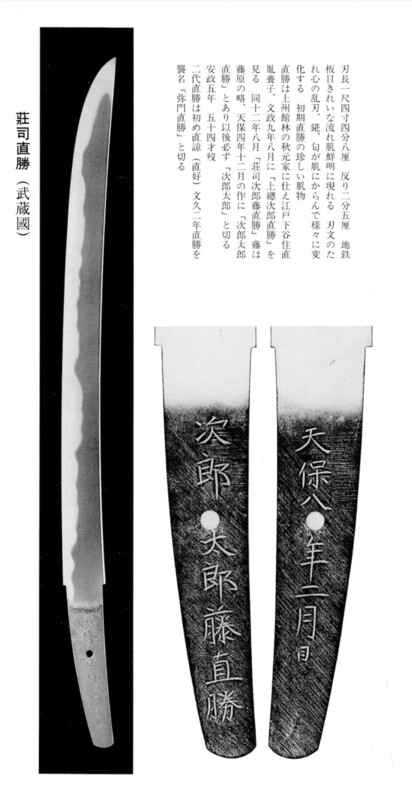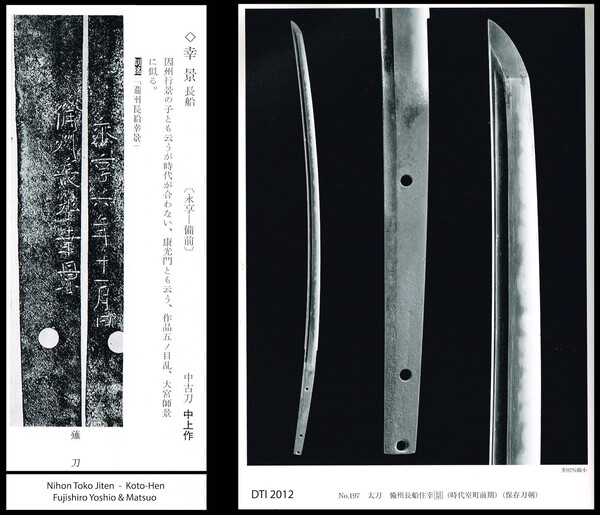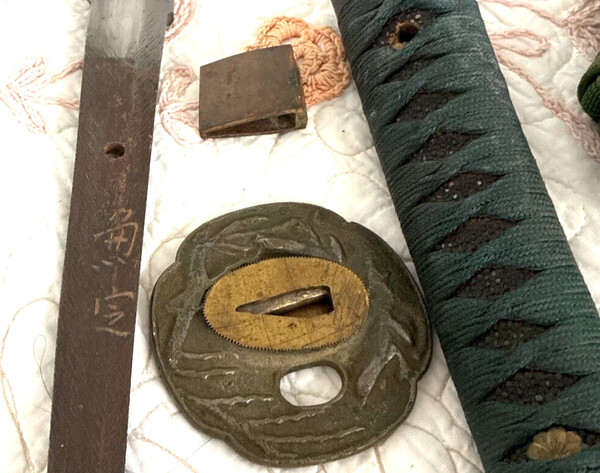-
Posts
779 -
Joined
-
Days Won
1
Content Type
Profiles
Forums
Events
Store
Downloads
Gallery
Everything posted by reinhard
-
Just for information: Kin-pun mei (gold-lacquer attributions) were made no earlier than Meiji-period and are not very reliable, to say the least. Old Hon'ami attributions were always done in kin-zogan (gold-inlay). Unfortunately for fakers this is much more difficult to counterfeit than kin-pun. reinhard
-
A once promising thread slowly drifting into the arena of the unwell. reinhard
-
There are no pros and cons comparing Etchu Norishige and Jiro Taro Naokatsu. They lived 500 years apart and both of them did extremely well. Norishige has the bonus of being the inventor, being the original one. Naokatsu on the other hand mastered the task of reproducing Norishige's work in a most stunning way. He cleared the super-wild and most-exaggerated style of Norishige and brought it into a more dignified form. And he accomplished this task on a very high level. Whatever you like better personally; it's not an absolute competition. Both smiths deserve our highest respect and are worth a very close look at. reinhard
-
Thank you for joining me during this casual intermezzo. Basic inspiration is, of course, Etchu Norishige. Next in line is Ono Hankei. But the maker here is Jiro Taro Naokatsu, master-student of Taikei Naotane. reinhard
- 16 replies
-
- 13
-

-

-
This is not a proper kantei, for I won't give you the exact measurements of the blade. Just an exercise to sharpen your view. The blade is a rather short wakizashi made in hira-zukuri shape. Any idea when and where it was made or even who the maker was? reinhard
-

What makes a sword a masterpiece?
reinhard replied to Hoshi's topic in General Nihonto Related Discussion
"I often wonder, how much control the smiths had - and, how much is happy accident." When it comes to swords, mastery is defined by control. It is different with tea-cups, for example. Accidental results beyond control during the burning process can enhance the value of a tea-cup. This is not the case with swords. reinhard -

What makes a sword a masterpiece?
reinhard replied to Hoshi's topic in General Nihonto Related Discussion
In order to give you a visual idea what separates a masterpiece from the better-than-average work, I'd like to show you a comparison. One blade is a masterpiece by Osafune Mitsutada made around middle of Kamakura-period. It airs a supreme yet relaxed mastery of forging and tempering in all aspects; dignity as well, if you want. The other blade is a work of Edo Ishido Tsunemitsu from Kambun-era. It is a very well made blade with brightly shining nioi-guchi, utsuri and all traits of a good choji-midare hamon. (The images were made by master-polisher Fujishiro Okisato and show the real nioi-guchi without hadori-finish) One blade I call a masterpiece; the other a very well made blade. Hope this is is helpful. reinhard -

What makes a sword a masterpiece?
reinhard replied to Hoshi's topic in General Nihonto Related Discussion
"Japanese aesthetics though are more tricky to understand and are not just "in the eye of the beholder", which is a silly Western concept" I'm curious about this. Could you elaborate? (Jeff) A question to write a book about, but I will try: Japanese swords were not made in a vacuum. The sense for their appreciation and beauty is embedded in a culture long gone and hard to understand even for (modern) Japanese people. Even more so for us Westerners. Usually we tend to enjoy and acclaim features we can easily recognize and understand within the perimeters of our cultural background. An example for this attitude on a very high level: Etchu NORISHIGE is considered a top-swordsmith within Soshu-style of sword-making for good reasons. Western collectors are crazy about his works, for their contrast in jihada and their obvious hataraki are so spectacular. But old Japanese connaisseurs considered his work clearly inferior to MASAMUNE's and SADAMUNE's. Why? Because of its lack of dignity! "What does that suppose to mean: dignity? In 2025 we are living in a world stripped of pride and dignity! Let's make ourselves shine by all means possible." Well, samurai's aesthetics didn't work that way. My advice: Learn the difference between "aki ni sae" and just brightly shining nioi on a hamon. Furthermore study Japan's history and craftsmanship, especially paintings, sculpture, calligraphy and even everyday objects. It is a long way to go, but it is very helpful to understand appreciation of Nihon-To. reinhard -

What makes a sword a masterpiece?
reinhard replied to Hoshi's topic in General Nihonto Related Discussion
"To my mind, it's a sword that exemplifies the best aesthetics, forging and metal for its place and period. Sometimes its also a sword that was part of breaking new ground in practice or aesthetics." (Robert S.) Well spoken and fully agreed with. But just for consideration: The criteria for excellence in metal quality and forging can be easily learned on an objective scale. Japanese aesthetics though are more tricky to understand and are not just "in the eye of the beholder", which is a silly Western concept. reinhard -
For those interested: The mei reads "Moritsugu" for sure. You find the sword in an ongoeing auction at www.rockislandauction.com in Texas. Problem is: The sugata on the pics looks like very old (Ko-) Aoe work. This could explain the mei on the sashi-ura, for some of the Aoe-smiths signed their tachi contrary to common practice. But: The nakago looks quite "fresh", unaltered and with one mekugi-ana. The kengyo-butt could point to Chikuzen-Kongobyoe school as Ray Singer already pointed out. Maybe a Southerner finds the time to check it out in hand. reinhard
-
"The Craft of the Japanese Sword" is an excellent book helping to understand the technical aspects of forging a proper Nihon-To. It helps understanding the difference between a mere tool and an object of beauty within objective parameters not easy to comprehend for an outsider. A most common misunderstanding still; especially here on this board, where the fruitless discussions about art and the qualities of Nihon-To never end. reinhard
-

Please help Wakizashi identification
reinhard replied to Steven6's topic in General Nihonto Related Discussion
Some more information about Yukikage: There were two smiths working under the same name in Bizen during first half of the 15th century. The mei on your blade fits only the one working in Osafune during Oei to Eikyo-years. He was the son of Inshu Yukikage and later associated with Yasumitsu in Osafune. His workmanship was similar to that of Omiya Morokage. reinhard -
Forgot to tell you find the translation of the above in English Token Bijutsu No.5 page 9. reinhard
-
Just some additional information: The mei of the Kunimitsu-blade with the nengo "Kagen 4" (1306) has been seen critical for a long time now. Dr.Homma Junji noted in 1984 ("Kanto Hibi-Sho") his doubts about the mei. reinhard
-
Since there is a tanto by Shintogo Kunimitsu (Juyo Bunkazai in the Atsuta Jingu) with a Toku-Ji san-nen nengo as well, it should be compared first to the blade in question. Much has been said about the kanji for "Kunimitsu". I see inconsistencies to Kunimtsu's traits in both kanji; too many for me to explain it with student's work. The first, horizontal part of the 2nd stroke of the kanji "Kuni" is "hanging" down. As mentioned before, the 4th stroke should be close to vertical and be in line with the first stroke of "Mitsu" The hokkan-style of the upper part of "Mitsu" is missing. Student's work...maybe, but I'm sceptical- What really bothers me is the writing of the nengo. It looks completely different in style and proportions compared to the Bunkazai. reinhard
-
The tsuka is wrapped the wrong way. The crossings of the Ito must alternate right over left, left over right...and so on, which is not the case here. The mei looks to me as if it had been scratched(?) over an artificially blackened tang. Agree with cast tsuba of non-Japanese origin and very bad filemarks on nakago. All in all a spurious assembly of parts. Sorry Olga reinhard
-
Usually the difference between mune-kasane and shinogi-kasane is neglectable in blades made of the shinogi-tsukuri type. Some blades however show a difference so remarkable the widths should be mentioned separately. Some scholars do, others don't. reinhard
-
Do not forget: It's the polishing technique that makes utsuri visible, or not. For a long time people believed, utsuri was an old, lost quality, forgotten during Edo-times. They were proven wrong by increased polishing techniques. What makes the difference now: Kind and quality of the utsuri! reinhard
-

Question about blade scratches
reinhard replied to Matt D's topic in General Nihonto Related Discussion
There was a time, not so long ago, when many collectors and dealers switched from washi to micro-fibre tissues for sword care. The disadvantage was: This kind of synthetic tissue picks up loose particles of rust from the tang and rubs them over the blade, producing ugly scratches. just an idea reinhard -
The estimated price is way too high. Reminds me of past days in the 80ties and 90ties, but this golden age for dealers is over. Shinto-To should have its mei at least partially. O-suriage is a no-go. reinhard
-

Thought of new idea, electroforming of swords and knives
reinhard replied to Mustafa Umut Sarac's topic in Nihonto
Keep on dreaming on the tip of the iceberg. reinhard -

Thought of new idea, electroforming of swords and knives
reinhard replied to Mustafa Umut Sarac's topic in Nihonto
This conversation is drifting into the arena of the absurd. In order to verify a fake google/gmail-acount I should "google" it? Are you serious? reinhard -
"Crap material"? You better start on field one. Obviously you haven't understood basics. reinhard
-

Thought of new idea, electroforming of swords and knives
reinhard replied to Mustafa Umut Sarac's topic in Nihonto
A gmail account doesn't proove anything. reinhard -

Thought of new idea, electroforming of swords and knives
reinhard replied to Mustafa Umut Sarac's topic in Nihonto
Mustafa wrote: "This idea is copyrighted worldwide and others can not patent the ideas here." Well, Mustafa, I don't intend to steal your ideas. I think nobody does. What you don't understand is: Producing replicas on the basis of new technologies is of no interest here. Your rude and highly aggressive attitude has a suicidal touch, as far as this board is concerned. Reminds me of a character kicked of this board not so long ago. But maybe that is what you want. Anyway, I am a chess-player and it seems you don't understand basics. reinhard












